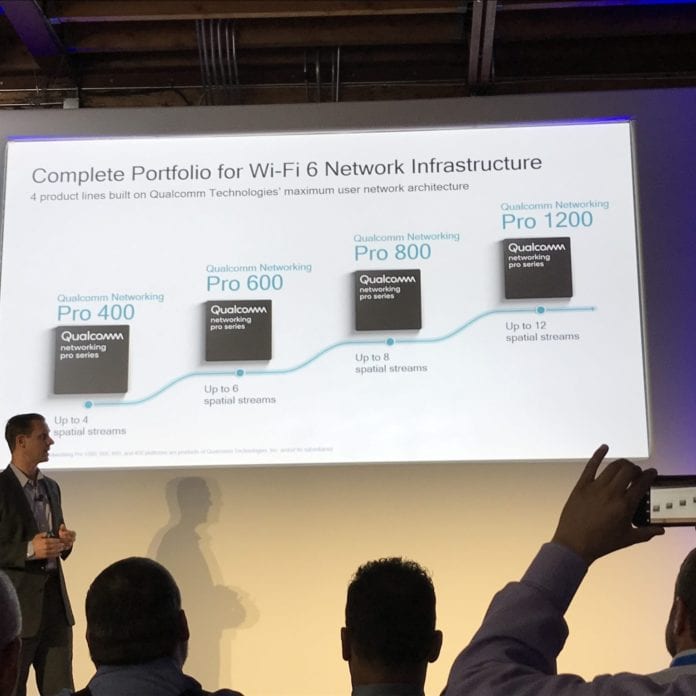Qualcomm execs: the biggest thing happening in Wi-Fi 6 is uplink technology
SAN FRANCISCO–Aiming to set a new benchmark in Wi-Fi 6 performance, Qualcomm used its Wi-Fi 6 Day event to announce its Networking Pro Series, an update to its Wi-Fi 6 portfolio. The series is comprised of four distinct platforms: the 400, 600, 800 and 1200 platform that support up to four, six, eight and 12 spatial streams, respectively.
Before announcing the new product line, Nick Kucharewski, VP and GM, Networking Infrastructure at Qualcomm, explained that as the definition of connectivity evolves, new metrics for how we think about Wi-Fi networks must be considered.
“First of all, connectivity is not just about how many bars we have,” Kucharewski explained. “It’s about things like rate versus range, or how much bandwidth am I getting when I’m this far away from the access point. Secondly, connecting to the network is not just about figuring out what SSID to join and then joining that network. It’s about understanding how many people are using that network.”
While Wi-Fi 6 was developed specifically to solve what Kucharewski referred to as “the modern challenges of high-density Wi-Fi networks,” he also commented that new Wi-Fi standards are not enough, and that the development of new software and network infrastructure are equally important.
The Qualcomm Networking Pro Series platforms, which are all implemented on a system on chip (SoC) architecture that employs a quad-core A53 processor, addresses this need for new network infrastructure. The four platforms, while fundamentally similar, offer increasing throughput and processing power as you approach the higher-end variants. Those higher-end variants also allow support for additional features.
The platform features 8×8 radio support, which improves rate vs. range and expands overall available capacity by offering up to 12 full streams of Wi-Fi 6 connectivity (in the 1200 tier), including eight streams of Wi-Fi 6 connectivity in the 5 GHz band. The network architecture has also been designed to associate and maintain connectivity for up to 1,500 clients simultaneously.
“That’s 1,500 users that are […] attempting to transfer data at the same time,” Kucharewski said. “That is a significant new innovation in Wi-Fi technology.”
The solution supports 1024 QAM, the Wi-Fi 6 modulation scheme, enabling up to 38% higher raw throughput vs. Wi-Fi 5, and features enhanced security for the full WPA3 security suite (Personal, Enterprise, Opportunistic Wireless Encryption, Easy Connect).
But, at Wi-Fi 6 Day, the features that got the most attention and were more than once deemed “the biggest thing happening in Wi-Fi 6” were those that better support uplink technology. Wi-Fi 6 offers an improved version of MU-MIMO that lets devices respond to the wireless access point at the same time, letting the access point talk to multiple devices at once. Wi-Fi 6 also utilizes a channel access method called OFDMA that allows for the division of a wireless channel into a large number of sub-channels, with each one carrying data intended for a different device.
The combination of OFDMA and MU-MIMO seems to be Wi-Fi 6’s secret weapon and is what allows the new generation of Wi-Fi to achieve increased capacity and improved coverage in high-density environments, and as the number of connected devices in the average household continues to drastically increase, the high-density challenge is beginning to hit closer to home.
The Qualcomm Pro Series supports MU-MIMO in the downlink and uplink across all bands, ensuring maximum network capacity, and OFDMA in the downlink and uplink across all bands with up to support for 37 users per 5 GHz channel used.
Kucharewski concluded his presentation by stating that solutions like the Pro Series will lead to innovation across the entire industry. “We will see a new generation of Wi-Fi 6 products.”

